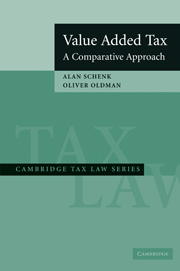Book contents
- Frontmatter
- Contents
- List of Tables, Figures, and Charts
- List of Cases
- Preface to the Revised Edition
- Value Added Tax
- 1 SURVEY OF TAXES ON CONSUMPTION AND INCOME, AND INTRODUCTION TO VALUE ADDED TAX
- 2 FORMS OF CONSUMPTION-BASED TAXES AND ALTERING THE TAX BASE
- 3 VARIETIES OF VAT IN USE
- 4 REGISTRATION, TAXPAYER, AND TAXABLE BUSINESS ACTIVITY
- 5 TAXABLE SUPPLIES OF GOODS AND SERVICES, AND TAX INVOICES
- 6 THE TAX CREDIT MECHANISM
- 7 INTRODUCTION TO CROSS-BORDER ASPECTS OF VAT
- 8 TIMING, TRANSITION AND VALUATION RULES
- 9 ZERO RATING AND EXEMPTIONS AND GOVERNMENT ENTITIES AND NONPROFIT ORGANIZATIONS
- 10 GAMBLING AND FINANCIAL SERVICES (OTHER THAN INSURANCE)
- 11 INSURANCE
- 12 INTERJURISDICTIONAL ASPECTS OF VAT IN FEDERAL COUNTRIES AND COMMON MARKETS
- 13 REAL PROPERTY
- 14 PROPOSALS FOR U.S. TAX ON CONSUMPTION
- APPENDIXES
- Index
8 - TIMING, TRANSITION AND VALUATION RULES
Published online by Cambridge University Press: 06 January 2010
- Frontmatter
- Contents
- List of Tables, Figures, and Charts
- List of Cases
- Preface to the Revised Edition
- Value Added Tax
- 1 SURVEY OF TAXES ON CONSUMPTION AND INCOME, AND INTRODUCTION TO VALUE ADDED TAX
- 2 FORMS OF CONSUMPTION-BASED TAXES AND ALTERING THE TAX BASE
- 3 VARIETIES OF VAT IN USE
- 4 REGISTRATION, TAXPAYER, AND TAXABLE BUSINESS ACTIVITY
- 5 TAXABLE SUPPLIES OF GOODS AND SERVICES, AND TAX INVOICES
- 6 THE TAX CREDIT MECHANISM
- 7 INTRODUCTION TO CROSS-BORDER ASPECTS OF VAT
- 8 TIMING, TRANSITION AND VALUATION RULES
- 9 ZERO RATING AND EXEMPTIONS AND GOVERNMENT ENTITIES AND NONPROFIT ORGANIZATIONS
- 10 GAMBLING AND FINANCIAL SERVICES (OTHER THAN INSURANCE)
- 11 INSURANCE
- 12 INTERJURISDICTIONAL ASPECTS OF VAT IN FEDERAL COUNTRIES AND COMMON MARKETS
- 13 REAL PROPERTY
- 14 PROPOSALS FOR U.S. TAX ON CONSUMPTION
- APPENDIXES
- Index
Summary
The timing (or tax accounting) rules are used to identify the tax period in which a taxpayer must pay tax on imports, report taxable sales, and claim deductions or credits for tax paid on allowable imports and domestic purchases. When a VAT is introduced or the rate is changed, transition rules are needed to identify if sales and purchases are made before or after the effective date of the new or modified VAT.
VAT generally is imposed on the amount of money and the value of nonmonetary consideration received for a taxable supply. Special valuation rules are provided for particular transactions. This chapter covers the timing, transition, and valuation rules.
THE TIMING RULES
ACCRUAL, INVOICE, AND CASH METHODS – IN GENERAL
This section discusses the rules governing the basic methods of accounting for VAT. It does not discuss the innumerable varieties of special schemes for retailers that are available in many countries.
Some countries do not allow any person to use the cash method. Other countries permit registered persons who meet the statutory conditions (usually related to a lower level of taxable turnover) to report on the cash method.
The limits or prohibitions against the use of the cash method are imposed in order to prevent the mismatching that occurs if the seller can defer the payment of output tax to the government, yet the buyer can claim an immediate credit.
- Type
- Chapter
- Information
- Value Added TaxA Comparative Approach, pp. 224 - 262Publisher: Cambridge University PressPrint publication year: 2007



